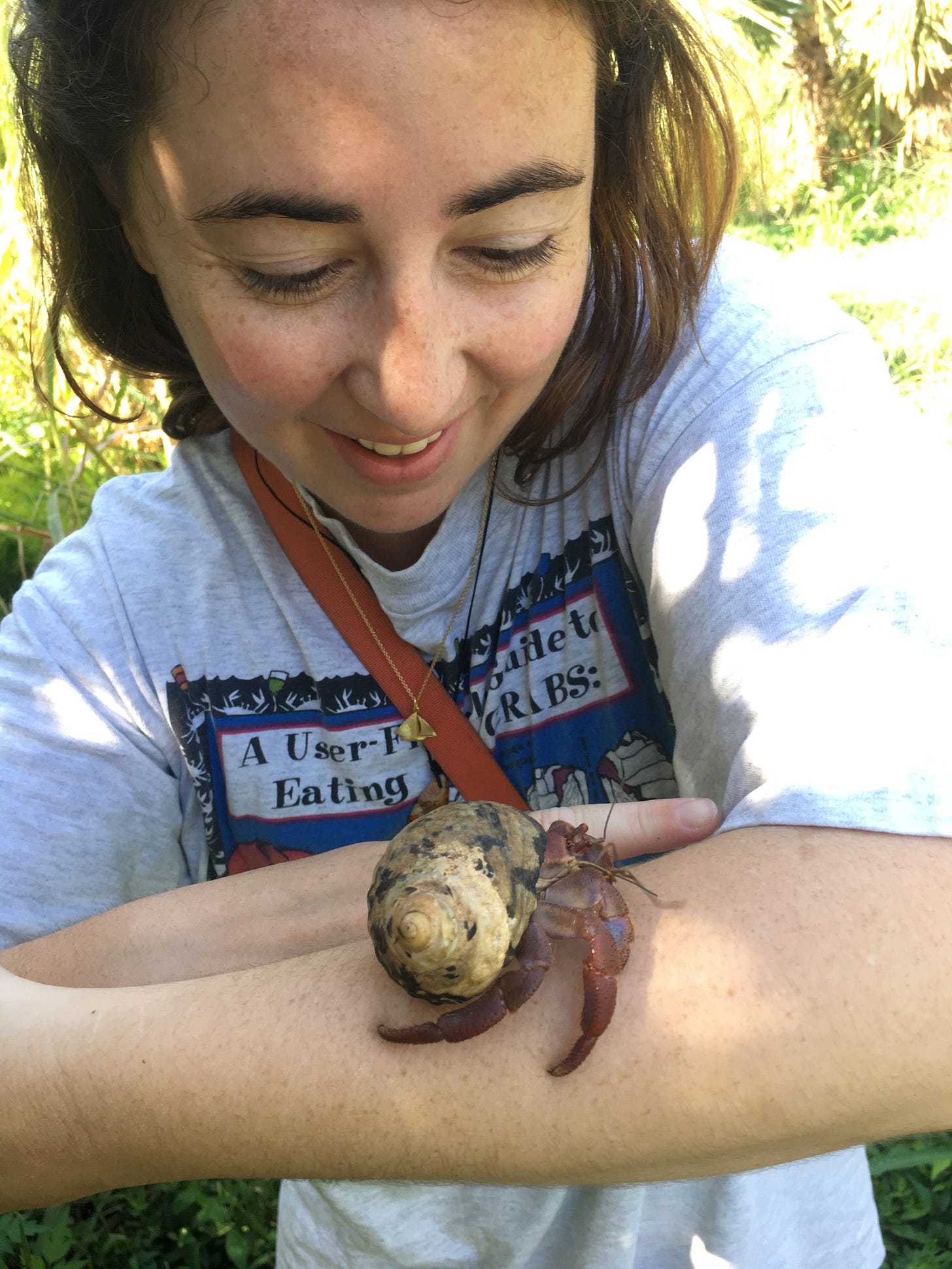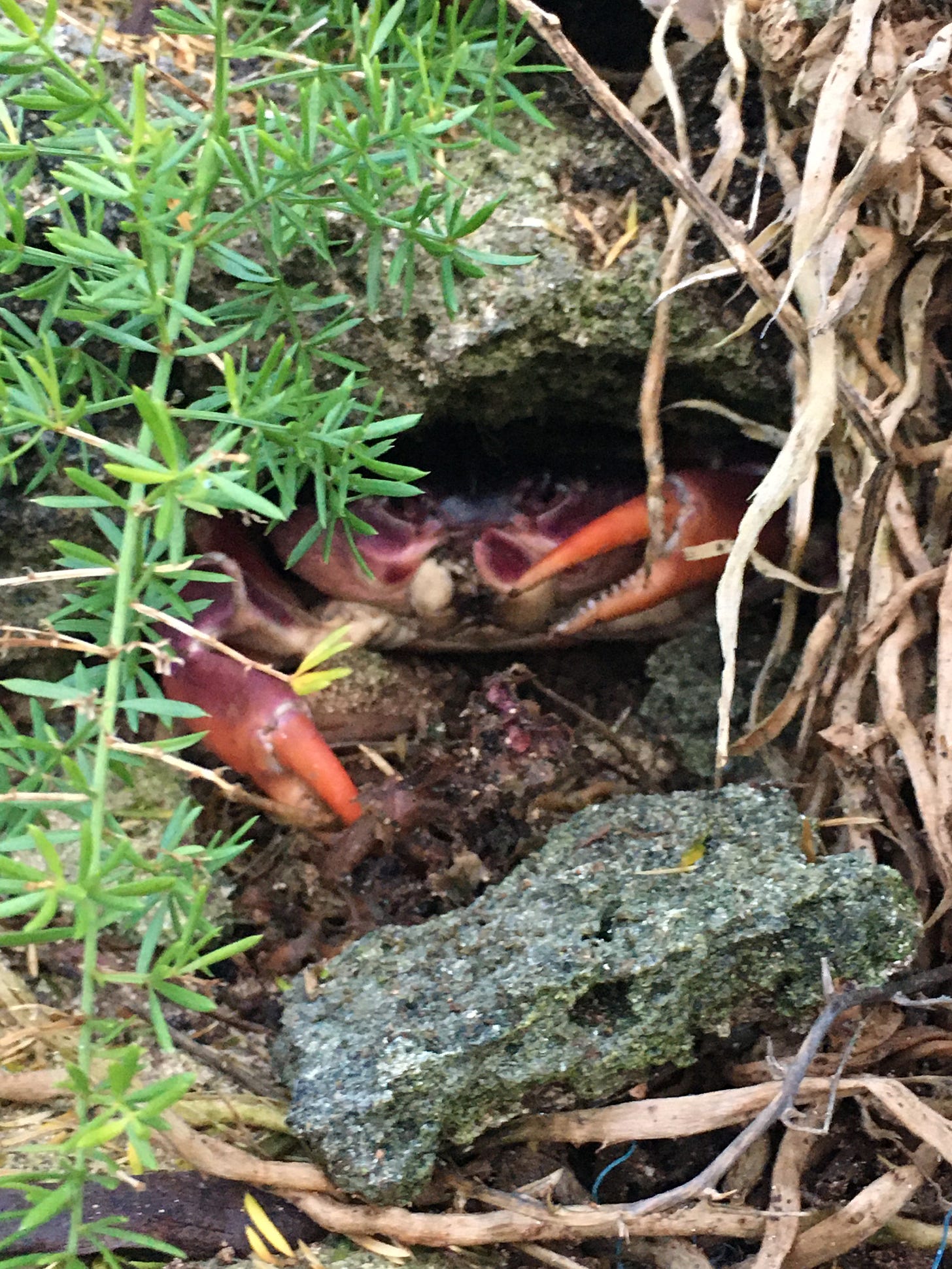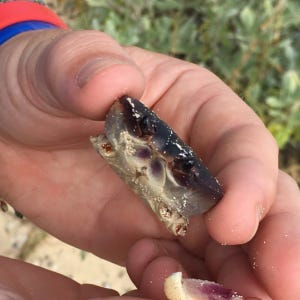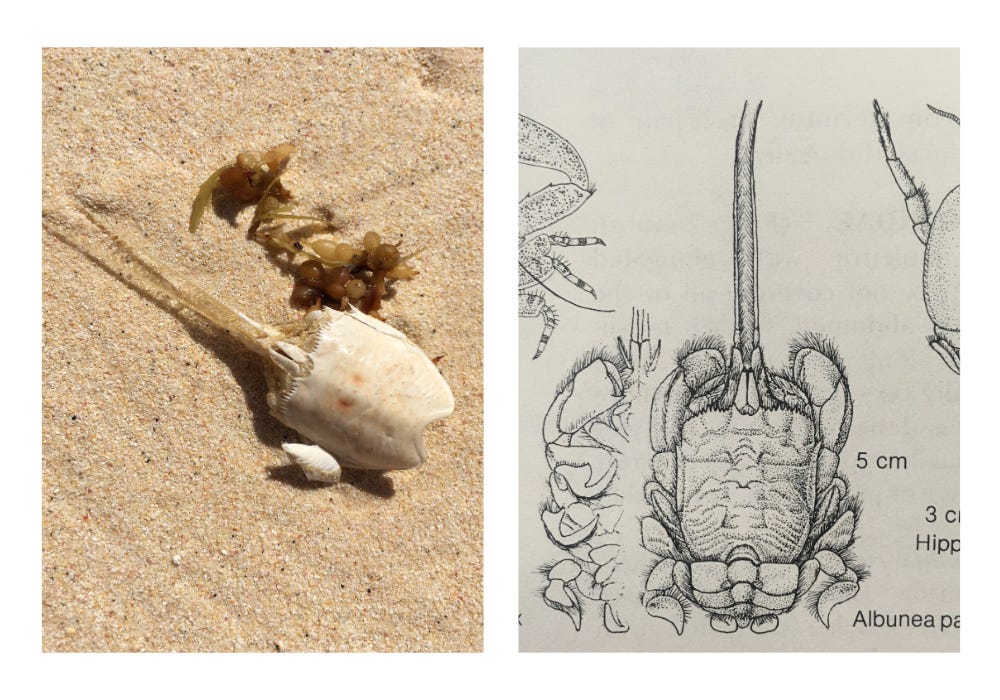I’ve had a suspicious amount of crab encounters lately - 5 significant ones in the past two weeks - and that anecdotal experience is hurtling me towards an inevitable conclusion: something is UP with crabs right now in Bermuda. What happened? I’ll tell you:
An unusual rustling at Cooper’s island. When you’ve heard a lot of rustles you will know: you can instantly tell if that sound belongs to a rat or a lizard. This was something different. Slower. More gangly. I peeled the underbrush away to reveal - a red land crab! She froze. I froze. There is plenty of evidence of red land crabs at Cooper’s - I find multiple severed claws there every time I go - which, it’s important to note, are from heron predation activity, rather than the crabs molting. But this was one of the only times in my life I’ve seen a living, breathing red land crab.
Heart attack in the car as I realise I’m on a collision course with - a red land crab. Luckily she was much too quick for me, and made it to the other side safely, but we had a moment where time stopped, where each of our velocities matched the other so it seemed as if we weren’t moving at all, where through the eye contact we shared, we became one being. I actually stopped the car after this and hopped out to see if I could find her, but she was gone - definitely not smashed on the road, but had simply slipped away into the secrecy of leaf litter from the rubber tree on the other side - on the way to Shelly Bay.
A very special encounter with a land hermit crab at Cooper’ Island! You can see my little video hanging out with him on Instagram. This experience made me feel pure joy - I could not stop smiling, and I think it may have been a combination of two very important factors: 1. the fact that these crabs are so rare now, and it was my first time seeing one since I was a kid, and 2. the fact that these animals are so interactive, easy to observe, and in their bumbling way have the power to make people fall in love with the ocean, and coastal conservation. More on that later!
A little red face peering out at us from the wall at Tobacco Bay at dusk! This crab was stock still. And it was very big. My boyfriend spotted it and he thought it was a molt or dead at first. But crabs are great at standing still. Relying on t-rex rules, maybe? I don’t think anyone can say red land crabs have a claim to cryptic camouflage!
Finally - don’t read this one if you’re squeamish about body horror - a red land crab that had lost all its legs. My friend who worked with land crabs in the Bahamas tells me that it’s possible for crabs to still be alive without any legs - they can even come back from this loss, and regrow their legs in successive molts! As you can see, this one’s eyes were up and alert, and it was able to ‘bubble’ at its mouth. We did actually bring this crab home to see if we could help it restore its legs - but unfortunately it also had a wound on its cephalothorax, which it ultimately succumbed to. I wonder if it was caught by a heron, which prepared to eat it (they remove the limbs before scarfing the cephalothorax), but lost the head in the underbrush before they could finish the job.
What’s all this crab activity about? Red land crabs and land hermit crabs are coastal forest-dwelling animals. They require water to pass over their gills to breathe - red land crabs keep a well of water in their underground burrows to serve this purpose, and land hermit crabs can store a little water in their shells, or breathe with the humidity in the air - but with all that being said, these animals are not marine crabs. They are as far away from marine crabs as you can get - land hermit crabs climb trees! But both of these species must return to the ocean to breed.
The females must make the journey from their inland/coastal habitats to the water’s edge, throw up their hands, and jiggle their eggs out of the pouch in their abdomens where they are stored. This journey to the ocean is called ‘running,’ my crab friend tells me - and the season for it appears to be late August/early September in Bermuda (based off my anecdotal observations). They risk life and limb - the odyssey does not just expose them to predators on the beach, but also forces them across roads with speeding cars (including mine) and other aspects of human development that place barriers between them and the ocean.
The larvae for both these species develop as free floating plankton in the wide ocean, eventually returning to land later. Both the red land crab and the land hermit crab have been significantly diminished in Bermuda.
Red land crabs in particular used to overrun the island - they would cover the roads, they would dot golf courses with their burrows, they would be crawling up the drapes inside your home. My mother tells me a story of when she was a kid, rushing into the bathroom because she had to pee so badly, sitting on the toilet and then realising she was right across from a red land crab! She was putting her hands up in shock, the crab was putting its claws up in shock, both of them too close for comfort to the other with nowhere to go!
What changed? Well, yellow crowned night herons were introduced. Bermuda did have a night heron that was wiped out by early settlers - Wingate found it in our fossil record. So he introduced the yellow crowned night heron to fill that niche. They were hand raised on Nonsuch Island on red land crabs. Critics blame Wingate for the dramatic decline of red land crabs in Bermuda - but the argument could be made that this is simply a more natural amount of crabs to be in the ecosystem, balanced out with a predator now which they didn’t have before. Red land crabs are for sure still around - though their population isn’t so ridiculous that they invade homes. Now, they keep to their underground burrows, rarely coming out except in running season.
As for the land hermit crabs, their problem was more of a housing crisis. West Indian top shells are the only shells big enough for hermit crabs in Bermuda, and when they were overharvested to the point of local extinction by early settlers, only a few land hermit crabs persisted, using fossilised top shells. Even into the 1980s, land hermit crabs could be seen in Bermuda, but top shells were still scarce - and there are photos of the exposed hermit crabs using plastic trash for shelter in place of a shell. Maybe if those images could go viral like the straw up a turtle’s nose, there would be enough political pressure to get our single use plastics ban passed, or to overhaul Bermuda’s waste system completely. Top shells were reintroduced in the 1980s and their populations have exploded! You can’t find a coast without them - so hopefully their increasing numbers will help land hermit crab populations to recover, too.
The biggest thing I noticed after sharing that video of me with a hermit crab at Cooper’s Island was the outpouring of love and wonder for this animal, connected especially to its scarcity. It’s a cruel feeling - to feel nostalgia for an animal. As my boyfriend said, “haven’t you ever had a hermit crab as a pet?” - at one time handling these animals was a rite of passage for every Bermudian child, as ordinary as spending an afternoon catching lizards with a piece of straw in a noose. The response to my video of a hermit crab was for people to reminisce on how long it’s been since they had seen one - or for people to say they didn’t know Bermuda had them at all.
For the period August 28-September 11, 2024
This week I want to focus on one very special find: a mole crab! Has anybody ever heard of this thing? I certainly hadn’t. Mole crabs are squat little creatures that inhabit the splash zone on sandy beaches. They burrow in the sand and use their antennae for filter-feeding tasty morsels out of the wash. Now, I’m familiar with the littoral zone - rockpools, tidepools; that incredible ecosystem where animals must endure dramatic changes in heat, salinity, tide. But I am not familiar at all with animals living in the sandy splash zone - a high octane place to live.
The specimen I found is on the left, and the Sterrer book illustration is on the right. These kind of crabs look a bit unfinished, no? Like the printer ran out of ink for its back end. Research on the family Hippoidea tells me that mole crabs cannot walk! They use their legs to dig in the sand, and can swim with their tails. I haven’t been able to find out much more information about these crabs - but I have to admit I did get a RUSH when the Sterrer book listed them as rare, as I always do when adding new items to my beachcombing inventory like a video game.
A friend on Instagram tells me that these crabs used to be very numerous on South Shore in Bermuda - you could see where their antenna left a V in the sand as the waves receded, but that she hasn’t seen one in a long time. It’s unclear whether the crabs have declined, or whether they are very good at going unnoticed.
I will mention other finds from this week only briefly: two washed up parrotfish, some Sargassum berries (Sargassum has been non existent on our beaches for so long!), some fry forced onto the beach perhaps?, bryozoans on an ocean rock, and a cute little coconut!
A quick one actually from last newsletter’s timespan! This is an illegal fish pot washed up at Cooper’s Island after hurricane Ernesto. Fish pots were banned in Bermuda in 1990 in response to dramatic decline of reef fish. You can learn lots more about fish pots in Bermuda in a dedicated post on my website!
For this week’s guest appearances section I wanted to share another land crab encounter with the kind permission of Roger Beach. The triptych tells a poetic story. The bumbling activities of a land crab were revealed at Riddell’s Bay - the crabs are not subtle creatures and it made no efforts to cover its tracks where it had flattened the clover. Roger, being the kind citizen that he is, picked up the crab - concerned that he should be relocated to the beach. Before such decisions could be made, the crab expressed his displeasure with a powerful pinch!
Let’s hope we keep seeing more of these cantankerous crustaceans as time goes on! Thanks for reading, and join me next time for more beach bum activities.
Where to find me:
Instagram: https://www.instagram.com/sargassogirl/
Website: http://www.sargassogirl.com/
Etsy: www.etsy.com/shop/SargassoGirl




















